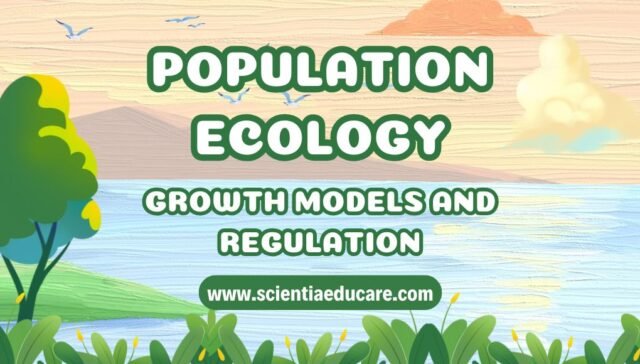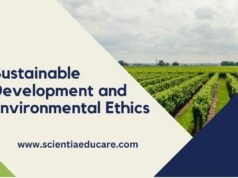Population Ecology: Understanding Growth Models and Regulation in Dynamic Ecosystems
Population ecology is a crucial branch of ecology that focuses on the study of populations, their size, structure, dynamics, and the factors that influence these characteristics. By understanding growth models and regulation mechanisms, ecologists can predict population trends and their impacts on ecosystems. This knowledge is vital for biodiversity conservation, resource management, and environmental sustainability.
Factors influencing population growth in ecosystems,
Understanding logistic and exponential growth in ecology,
Impact of carrying capacity on species population dynamics,
Density-dependent and independent factors in population regulation,
Case studies on predator-prey relationships in natural habitats,
Table of Contents
- Introduction to Population Ecology
- Population Growth Models
- Population Regulation Mechanisms
- Population Dynamics and Interactions
- Applications of Population Ecology
- Conclusion
- Relevant Links and Further Reading
Introduction to Population Ecology
Population ecology examines how populations of organisms grow, fluctuate, and interact with their environment. A population is a group of individuals of the same species inhabiting a specific area. Understanding population dynamics is essential for managing wildlife resources, controlling pest species, conserving endangered species, and assessing human impacts on ecosystems.
Population Growth Models
Population growth models help ecologists predict how populations change over time. Two primary models are used: the Exponential Growth Model and the Logistic Growth Model.
Exponential Growth Model
-
Description:
- The exponential growth model describes population increase under ideal, unlimited environmental conditions.
- The population grows at a constant rate per unit of time, leading to a J-shaped curve when plotted graphically.
-
Mathematical Representation:
dN/dt=rNdN/dt = rN
Where:- dN/dtdN/dt = Change in population size over time
- rr = Intrinsic growth rate
- NN = Current population size
-
Characteristics:
- Occurs in environments with abundant resources and minimal competition.
- Common in invasive species or populations recovering from a catastrophic event.
-
Limitations:
- Not sustainable in the long term due to resource limitations.
- Assumes no environmental resistance or carrying capacity constraints.
-
Example:
- Bacterial populations in a nutrient-rich culture exhibit exponential growth.
Logistic Growth Model
-
Description:
- The logistic growth model accounts for environmental resistance and resource limitations.
- It describes population growth that slows as the population approaches the carrying capacity (K) of the environment, leading to an S-shaped curve.
-
Mathematical Representation:
dN/dt=rN(K−NK)dN/dt = rN \left( \frac{K-N}{K} \right)
Where:- KK = Carrying capacity of the environment
-
Characteristics:
- Initially, the population grows exponentially, but growth slows as resources become limited.
- The population stabilizes at the carrying capacity.
-
Example:
- Deer populations in a forest ecosystem, where food and shelter limit population growth.
Population Regulation Mechanisms
Population sizes are regulated by a combination of density-dependent and density-independent factors.
Density-Dependent Factors
-
Definition:
- Factors whose effects on population size increase as the population density increases.
-
Examples:
- Competition: Intra-specific and inter-specific competition for resources like food, water, and space.
- Predation: Increased predation pressure as prey density rises.
- Disease: Higher transmission rates in densely populated areas.
- Parasitism: Parasite loads increase with host density.
-
Impact on Population:
- Helps maintain population stability by preventing overpopulation.
- Regulates population growth near the carrying capacity.
Density-Independent Factors
-
Definition:
- Factors that affect population size regardless of the population density.
-
Examples:
- Natural Disasters: Earthquakes, floods, fires, and hurricanes.
- Climate Extremes: Droughts, extreme temperatures, and storms.
- Human Activities: Habitat destruction, pollution, and climate change.
-
Impact on Population:
- Causes sudden and dramatic population declines.
- Influences population recovery and long-term dynamics.
Population Dynamics and Interactions
Population dynamics are influenced by interactions within and between species, including:
-
Predator-Prey Relationships:
- Fluctuations in predator and prey populations due to predation pressure.
- Example: Lynx and snowshoe hare population cycles.
-
Competition:
- Intra-specific competition affects population structure and resource allocation.
- Inter-specific competition influences species coexistence and community structure.
-
Mutualism and Commensalism:
- Positive interactions influencing population growth and stability.
Applications of Population Ecology
-
Wildlife Conservation:
- Managing endangered species populations.
- Designing effective wildlife reserves and corridors.
-
Pest and Disease Control:
- Predicting outbreaks and implementing control measures.
-
Fisheries Management:
- Ensuring sustainable harvesting by understanding fish population dynamics.
-
Human Population Studies:
- Analyzing human population growth and its impact on natural resources.
Conclusion
Population ecology provides essential insights into how populations grow, interact, and adapt to changing environments. By understanding growth models and regulatory mechanisms, ecologists can make informed decisions to conserve biodiversity, manage natural resources, and mitigate human impacts on ecosystems. The knowledge gained from population ecology is invaluable for sustainable development and environmental stewardship.
Relevant Links and Further Reading
Educational Resources
Research Articles and Journals
Further Reading
- Population Dynamics and Growth Models – National Geographic
- Carrying Capacity and Population Regulation – Nature Education
- Human Population Growth and Its Impact – Our World in Data
This comprehensive study module provides an in-depth understanding of population ecology, growth models, and regulation mechanisms. The relevant links and further reading resources enhance learning by offering additional insights and up-to-date research findings.
Multiple-Choice Questions on Population Ecology: Growth Models and Regulation
1. Which of the following best describes population ecology?
- A) Study of ecosystems and their energy flow.
- B) Study of individual organisms’ behavior.
- C) Study of populations, their size, growth, and interactions. ✅
- D) Study of the Earth’s climate and atmospheric patterns.
Explanation:
Population ecology focuses on how populations grow, fluctuate, and interact with their environment, including factors affecting population size and growth.
2. What is the primary focus of the exponential growth model?
- A) Limited resources and carrying capacity.
- B) Unlimited resources and constant growth rate. ✅
- C) Predator-prey interactions.
- D) Cyclic population fluctuations.
Explanation:
The exponential growth model describes population growth under ideal conditions with no resource limitations, resulting in a J-shaped curve.
3. In the logistic growth model, population growth slows as it approaches:
- A) Birth rate.
- B) Death rate.
- C) Carrying capacity (K). ✅
- D) Environmental resistance.
Explanation:
The logistic growth model accounts for environmental resistance, causing population growth to slow and stabilize at the carrying capacity.
4. Which equation represents the exponential growth model?
- A) dN/dt=rNdN/dt = rN ✅
- B) dN/dt=rN(K−NK)dN/dt = rN \left( \frac{K-N}{K} \right)
- C) dN/dt=K−NdN/dt = K – N
- D) dN/dt=r×KdN/dt = r \times K
Explanation:
The exponential growth model is represented by dN/dt=rNdN/dt = rN, where rr is the intrinsic growth rate, and NN is the population size.
5. Which growth curve is associated with the logistic growth model?
- A) J-shaped curve
- B) S-shaped curve ✅
- C) Linear growth curve
- D) Exponential decline curve
Explanation:
The logistic growth model produces an S-shaped curve as population growth slows near the carrying capacity due to resource limitations.
6. Density-dependent factors include:
- A) Natural disasters.
- B) Temperature extremes.
- C) Predation and competition. ✅
- D) Pollution.
Explanation:
Density-dependent factors, such as predation and competition, influence population size based on population density.
7. Which of the following is a density-independent factor?
- A) Disease spread
- B) Food competition
- C) Drought ✅
- D) Predation pressure
Explanation:
Density-independent factors, like droughts, impact populations regardless of their density, often leading to sudden declines.
8. The carrying capacity of an environment is defined as:
- A) Maximum population growth rate.
- B) Minimum viable population size.
- C) Maximum population size sustainable by resources. ✅
- D) Average population size over time.
Explanation:
Carrying capacity is the maximum population size that the environment’s resources can sustain over time.
9. Which factor can decrease the carrying capacity of an environment?
- A) Improved food supply.
- B) Habitat destruction. ✅
- C) Increased birth rates.
- D) Stable climate conditions.
Explanation:
Habitat destruction reduces available resources, lowering the carrying capacity of the environment.
10. In the logistic growth model, the term K−NK\frac{K-N}{K} represents:
- A) Environmental resistance. ✅
- B) Exponential growth rate.
- C) Birth and death rates.
- D) Predator-prey ratio.
Explanation:
This term represents environmental resistance, slowing growth as the population size approaches the carrying capacity.
11. Which of the following is an example of interspecific competition?
- A) Lions competing for mates.
- B) Deer and rabbits competing for vegetation. ✅
- C) Trees shading each other.
- D) Wolves hunting in packs.
Explanation:
Interspecific competition occurs between different species, such as deer and rabbits competing for the same vegetation.
12. Which population growth pattern is typically seen in invasive species?
- A) Logistic growth
- B) Cyclic growth
- C) Exponential growth ✅
- D) Negative growth
Explanation:
Invasive species often experience exponential growth due to a lack of natural predators and abundant resources.
13. Population cycles in predator-prey interactions are usually:
- A) Linear and stable.
- B) Cyclical and oscillatory. ✅
- C) Random and unpredictable.
- D) Constant and unchanging.
Explanation:
Predator-prey interactions often lead to cyclical population fluctuations, with predator numbers following prey population changes.
14. Which of the following best explains population overshoot?
- A) Population remains stable.
- B) Population exceeds carrying capacity temporarily. ✅
- C) Population declines to extinction.
- D) Population doubles in size rapidly.
Explanation:
Overshoot occurs when a population temporarily exceeds its carrying capacity, leading to resource depletion and subsequent decline.
15. A population’s growth rate becomes zero when:
- A) Birth rate equals death rate. ✅
- B) Immigration exceeds emigration.
- C) Carrying capacity is doubled.
- D) Environmental resistance is minimal.
Explanation:
Zero population growth occurs when the birth rate equals the death rate, leading to population stability.
16. The Allee effect occurs when:
- A) High population density increases competition.
- B) Low population density reduces reproduction and survival. ✅
- C) Population size exceeds carrying capacity.
- D) Environmental resistance is zero.
Explanation:
The Allee effect is a phenomenon where individuals have reduced reproductive success and survival at low population densities.
17. An example of a density-dependent disease is:
- A) Influenza in humans. ✅
- B) Drought-induced plant death.
- C) Earthquake-related injuries.
- D) Flood damage to animal habitats.
Explanation:
Influenza spreads more rapidly in densely populated areas, making it a density-dependent disease.
18. r-strategists are characterized by:
- A) Long lifespan and parental care.
- B) High reproductive rates and short lifespans. ✅
- C) Stable population size.
- D) Adaptation to stable environments.
Explanation:
r-strategists reproduce rapidly and in large numbers, thriving in unstable or unpredictable environments.
19. K-strategists typically:
- A) Exhibit rapid population growth.
- B) Have few offspring and long lifespans. ✅
- C) Experience frequent population crashes.
- D) Show no parental care.
Explanation:
K-strategists invest in fewer offspring with high parental care and longer lifespans, stabilizing near the carrying capacity.
20. Which model is more realistic for long-term population predictions?
- A) Exponential model
- B) Logistic model ✅
- C) Arithmetic model
- D) Static model
Explanation:
The logistic model is more realistic as it accounts for resource limitations and environmental resistance, unlike the exponential model.















Thank you for the auspicious writeup. It actually used to be a entertainment account it. Look advanced to far brought agreeable from you! By the way, how can we be in contact?